 W
WA California roll or California maki is a makizushi sushi roll that is usually rolled inside-out, and containing cucumber, crab or imitation crab, and avocado. Sometimes crab salad is substituted for the crab stick, and often the outer layer of rice in an inside-out roll (uramaki) is sprinkled with toasted sesame seeds or roe such as tobiko from flying fish.
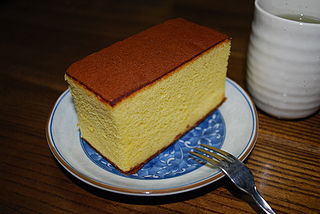 W
WCastella is a kind of wagashi originally developed in Japan based on the "Nanban confectionery". The batter is poured into large square or rectangular molds, baked in an oven and cut into long rectangular shapes. Since the recipe calls for mizuame, a type of sugar syrup, Castella has a moist texture.
 W
WChahan , also known as Yakimeshi, is a Japanese fried rice dish prepared with rice as a primary ingredient and myriad additional ingredients and seasonings. The dish is typically fried, and can be cooked in a wok. Chahan may have originated in the 1860s from Chinese immigrants arriving at the port of Kobe. Chahan is a staple food in homes in Japan. A variation of the dish is takana chahan. Some restaurants outside Japan serve the dish as a part of their fare.
 W
WChanpurū (チャンプルー) is an Okinawan stir fry dish. It is considered the representative dish of Okinawan cuisine. Chanpurū generally consists of tofu combined with some kind of vegetable, meat, or fish. Luncheon meat, egg, moyashi and gōyā are some other common ingredients. Spam is not typically used in mainland Japan; but it is more common in Okinawa due primarily to the historical influence of its introduction by the US Navy. Chanpurū is Okinawan for "something mixed" and the word is sometimes used to refer to the culture of Okinawa, as it can be seen as a mixture of traditional Okinawan, Chinese, mainland Japanese, Southeast Asian and North American culture. The term originates from the Malay or Indonesian word campur, meaning "mix".
 W
WChūkadon (中華丼) is a popular Japanese fast food dish. It consists of a bowl of rice with stir-fried vegetables, onions, mushrooms, and thin slices of meat on top. Literally meaning "Chinese rice bowl", it is inspired by Chinese cuisine. It is a kind of donburi.
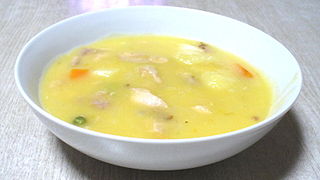 W
WCream stew is a popular Yōshoku dish consisting of meat, usually chicken or pork, and mixed vegetables, onion, carrot, potato and cabbage, cooked in thick white roux. The vegetables are sauteed before the meat is added with some water. The surface fats are removed by degreasing and then the roux is added. It is common in Japan to use ready-made roux, as for making Japanese curry, which comes in a block from a box. The roux though can also be cooked from scratch. The hard paste roux melts from the heat and blends with the water to create a thick stew. Milk can also be used as replacement for water, to make the stew more creamy.
 W
WHayashi rice or Hashed beef rice is a dish popular in Japan as a Western-style dish or yōshoku. It usually contains beef, onions, and button mushrooms, in a thick demi-glace sauce which often contains red wine and tomato sauce. This sauce is served atop or alongside steamed rice. The sauce is sometimes topped with a drizzle of fresh cream.
 W
WHorumonyaki is a kind of Japanese cuisine made from beef or pork offal. Kitazato Shigeo, the chef of a yōshoku restaurant in Osaka devised this dish and registered a trademark in 1940. It was originally derived from Yakiniku. The name horumon is derived from the word "hormone", which means "stimulation" in Greek. The name horumon is also similar to the Kansai dialect term hōrumon (放る物), which means "discarded goods". Horumonyaki has a reputation for being a "stamina building" food.
 W
WKorokke is the Japanese name for a deep-fried yōshoku dish originally related to a French dish, the croquette. Korokke is made by mixing cooked chopped meat, seafood, or vegetables with mashed potato or white sauce, usually shaped like a flat patty, rolling it in wheat flour, eggs, and Japanese-style breadcrumbs, then deep-frying this until brown on the outside.
 W
WLoco moco is a dish featured in contemporary Hawaiian cuisine. There are many variations, but the traditional loco moco consists of white rice, topped with a hamburger, a fried egg, and brown gravy. Variations may include bacon, ham, Spam, tofu, kalua pork, Portuguese sausage, teriyaki beef, teriyaki chicken, mahi-mahi, shrimp, oysters, and other meats.
 W
WMenchi-katsu (メンチカツ) is a Japanese breaded and deep-fried ground meat patty; a fried meat cake. The meat is usually ground beef, pork, or a mixture of the two. It is often served in inexpensive bento and teishoku.
 W
WNaporitan or Napolitan is a popular Japanese Yōshoku pasta dish. The dish consists of spaghetti, tomato ketchup or a tomato-based sauce, onion, button mushrooms, green peppers, sausage, bacon and optionally Tabasco sauce. Naporitan is claimed to be from Yokohama. An instant Naporitan is also available in Japan today.
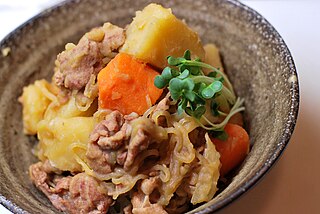 W
WNikujaga is a Japanese dish of meat, potatoes and onion stewed in sweetened soy sauce and mirin, sometimes with ito konnyaku and vegetables. Nikujaga is an example of yōshoku. Generally, potatoes make up the bulk of the dish, with meat mostly serving as a source of flavor. It is usually boiled until most of the liquid has been reduced. Thinly sliced beef is the most common meat used, although minced or ground beef is also popular. Pork is often used instead of beef in eastern Japan.
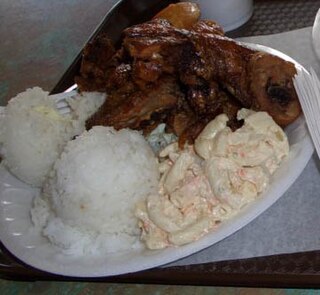 W
WThe plate lunch is a quintessentially Hawaiian meal, roughly analogous to Southern U.S. meat-and-threes. However, the pan-Asian influence on Hawaiian cuisine, and its roots in the Japanese bento, make the plate lunch unique to Hawaii.
 W
WTaco rice is a popular example of Okinawan cuisine. It consists of taco-flavored ground beef served on a bed of rice, frequently served with shredded cheese, shredded lettuce, tomato and salsa.
 W
WTempura is a typical Japanese dish usually consisting of seafood, meat and vegetables that have been battered and deep fried. The dish was introduced by Iberians in Nagasaki through the fritter-cooking techniques in the 16th century. The name "tempura" may originate from the Spanish Témporas or from the Portuguese Têmporas, which refer to the Ember Days, during which no meat is consumed, or from the Portuguese word tempêro, meaning “seasoning”.
 W
WTenshindon, also known as tenshinhan, is a Japanese-Chinese specialty, consisting of a crab meat omelette on rice, named from Tianjin in northern China.
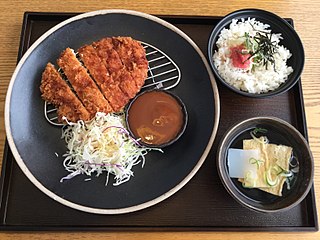 W
WTonkatsu is a Japanese dish that consists of a breaded, deep-fried pork cutlet. It involves coating slices of pork with panko, frying them in oil, and then serving with rice and shredded cabbage. The two main types are fillet and loin. Tonkatsu is also the basis of other dishes such as Katsukarē and katsudon.
 W
WYakiniku, meaning "grilled meat", is a Japanese term that, in its broadest sense, refers to grilled meat cuisine. "Yakiniku" originally referred to western "barbecue" food, the term being popularized by Japanese writer Kanagaki Robun (仮名垣魯文) in his Seiyo Ryoritsu in 1872. The term later became associated with Korean-derived cuisine during the early Shōwa period. Due to the Korean War, the terms associated with Korea in Japan were divided into North Korea and South Korea (Kankoku); the reference to a "yakiniku restaurant" arose as a politically correct term for restaurants of either origin.
 W
WIn Japanese cuisine, yōshoku refers to a style of Western-influenced cooking which originated during the Meiji Restoration. These are primarily Japanized forms of European dishes, often featuring Western names, and usually written in katakana. It is an example of fusion cuisine.